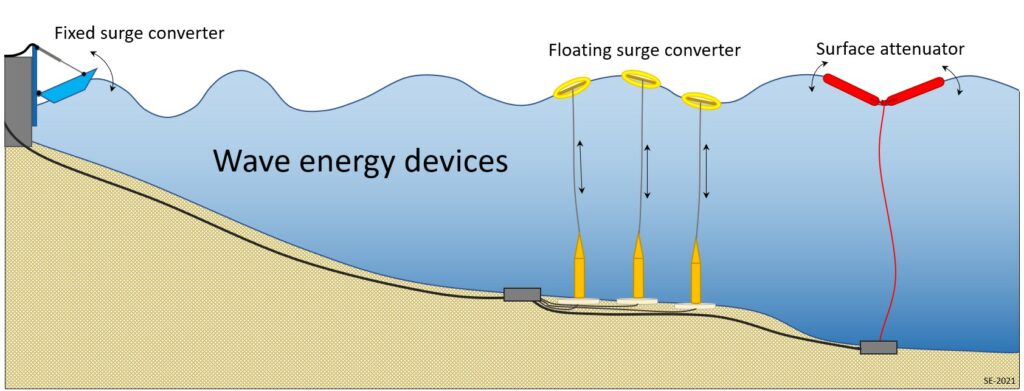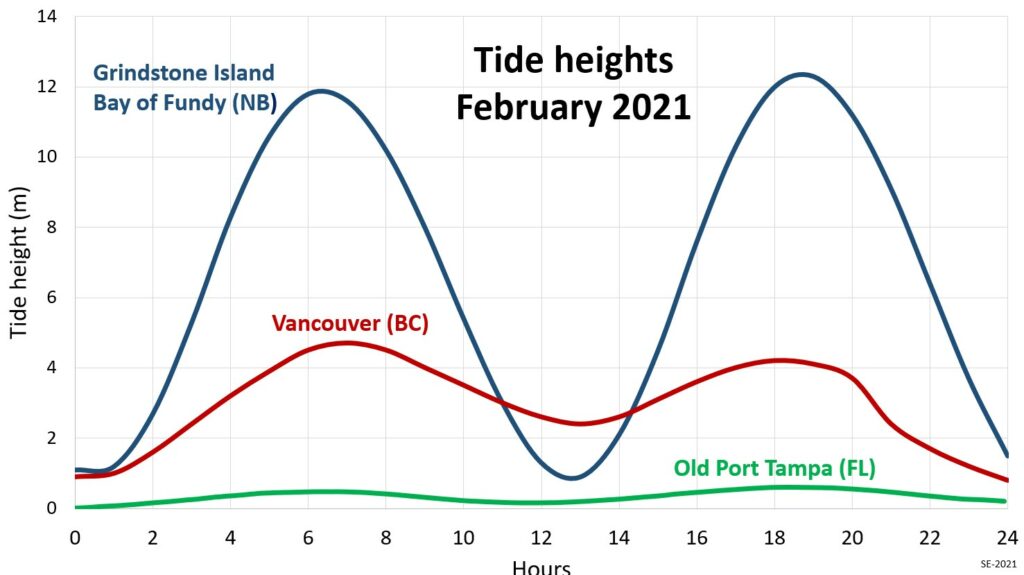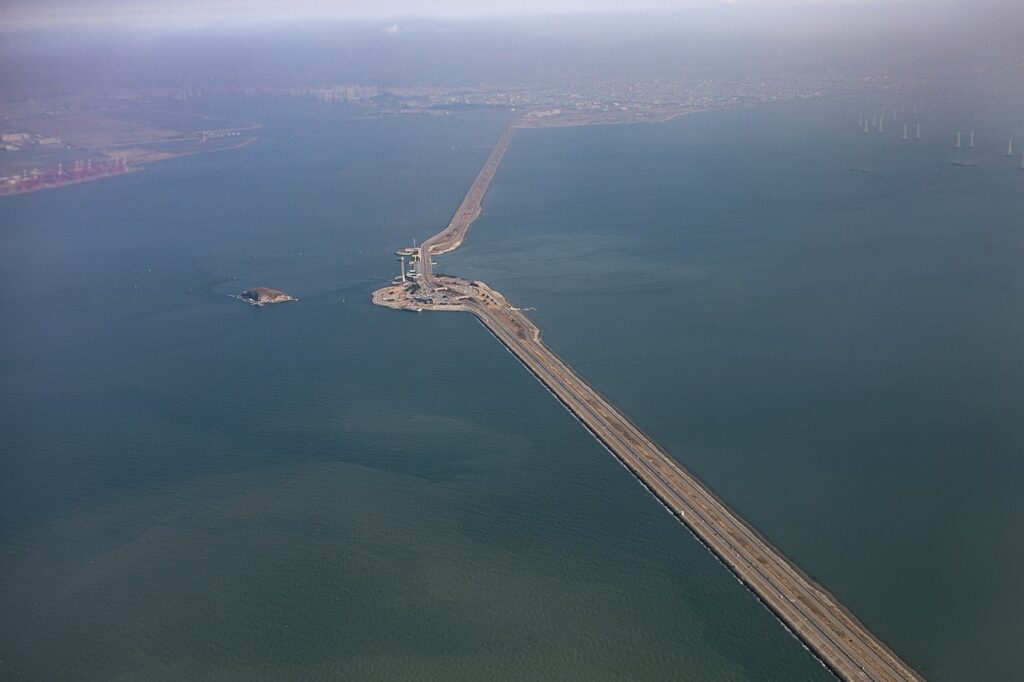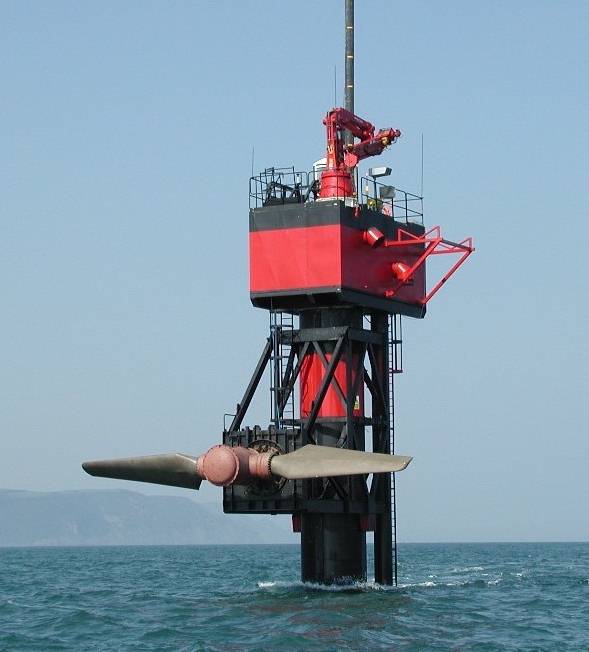9.3 Wave and Tidal Energy
Steve Earle
Waves are generated by wind blowing over water, so this form of energy originates from the sun. On the other hand, tides are related to rotation in the sun-Moon-Earth system and from the resulting variations in the gravitational force on Earth. That energy comes from the original angular momentum (spin) of the solar-system and the galaxy, and can possibly be traced right back to the Big Bang.[1]
Wave Energy
The size of waves at any location is a function of the strength of the wind, and also the extent of the body of water over which that wind blows. This factor is known as the “fetch”. The longer the fetch the bigger the waves. Waves tend to be short and steep close to a storm, but longer and shallower far away. Typical large ocean waves have wavelengths in the order of 100 m and amplitudes in the order of a few metres. While waves are driven by the wind, they tend to be somewhat more reliable than the wind as a source of energy. At most exposed coastal locations there will be some wave action, even if there is little or no wind at that time. In general, wave energy is greatest in the areas of greatest wind energy, as shown on Figure 9.1.5.
Several different wave energy devices have been designed and tested over the past several decades. They include shore-based systems, sea-floor tethered systems, and anchored floating systems that bend as waves pass. Some of these are illustrated on Figure 9.3.1. All of them have cylinders that are compressed and then relaxed every time a wave goes by, and the pressure created by that is converted into electricity.

Although all three of these types of systems have been demonstrated in the past, at present (spring 2021) the only operating and grid-connected wave energy installations are of the fixed-surge type, and those are small, with power ratings in the kilowatts, not megawatts.
Tidal Energy
The tides are generated by variations in the geometry of the sun-Earth-Moon system and the effect that those have on the level of the surface of the ocean. In most areas there are two high tides and two low tides every day (known as semidiurnal tides), although a few regions have only one high and one low per day (diurnal tides). The range between high and low tides is highly variable from place to place. The world’s highest tide range are in the order of 16 m difference between low and high tides in the Bay of Fundy between Nova Scotia and New Brunswick. On the other hand, many regions have tidal ranges of less than 1 m. Some examples of differing tidal ranges are shown on Figure 9.3.2.

There are several ways to convert tidal energy into electrical energy, but the two most commonly explored methods include the construction of a barrage (a dam) across a tidal estuary, and the installation of underwater turbines within channels that have significant tidal flow. The barrage method has been proven to be effective, but it can have serious environmental implications because a barrage results in changes to water-level fluctuations, salinity and turbidity in tidal flat areas, most of which are of great ecological importance. A tidal barrage is shown on Figure 9.3.3. The barrage acts like a dam, and the flow of both incoming and outgoing tides can be converted to electricity using turbines installed within the structure. There are three significant operating barrage tidal installations at present, including Sihwa Lake (South Korea, 254 MW, operating since 2011), La Rance River (France, 240 MW, operating since 1966) and Annapolis Royal (Nova Scotia, 20 MW, operated from to 1984 to 2019). Others have been proposed, but as of 2021, none is under construction.


The other main type of tidal system is a tidal stream turbine that is typically installed in a location with strong tidal currents. An example is shown on Figure 9.3.4. Most such devices are either embedded in, or resting on, the sea floor, although some are buoyant and are anchored to the sea floor. Based on information available in 2021, only one tidal stream is currently in operation, and that is the MeyGen project on the north coast of Scotland, which has four 1.5 MW sea-floor turbines connected to the grid, with more turbines reportedly to be under construction.
The potential for tidal energy is huge, but the engineering and environmental challenges are significant, and the high capital cost has been a barrier to implementation of many planned projects.
Media Attributions
- Figure 9.3.1 Steven Earle, CC BY 4.0
- Figure 9.3.2 Steven Earle, CC BY 4.0, based on public domain and Open Government Canada data from National Oceanographic and Atmospheric Administration, https://tidesandcurrents.noaa.gov/, and Fisheries and Oceans Canada, https://www.waterlevels.gc.ca/
- Figure 9.3.3 Sihwa Lake Tidal Power Station by Arne Müseler (arne-museler.com), CC-BY-SA-3.0, via Wikimedia Commons, https://commons.wikimedia.org/wiki/File:Sihwa_Lake_Tidal_Power_Station_aerial_view.jpg
- Figure 9.3.4 Seaflow Raised by Fundy, CC-BY-SA-3.0, via Wikimedia Commons, https://commons.wikimedia.org/wiki/File:Seaflow_raised_16_jun_03.jpg
- Commissariat, T. (2011). Was the universe born spinning? Cosmology Research Update. Physics World. https://physicsworld.com/a/was-the-universe-born-spinning/ ↵
